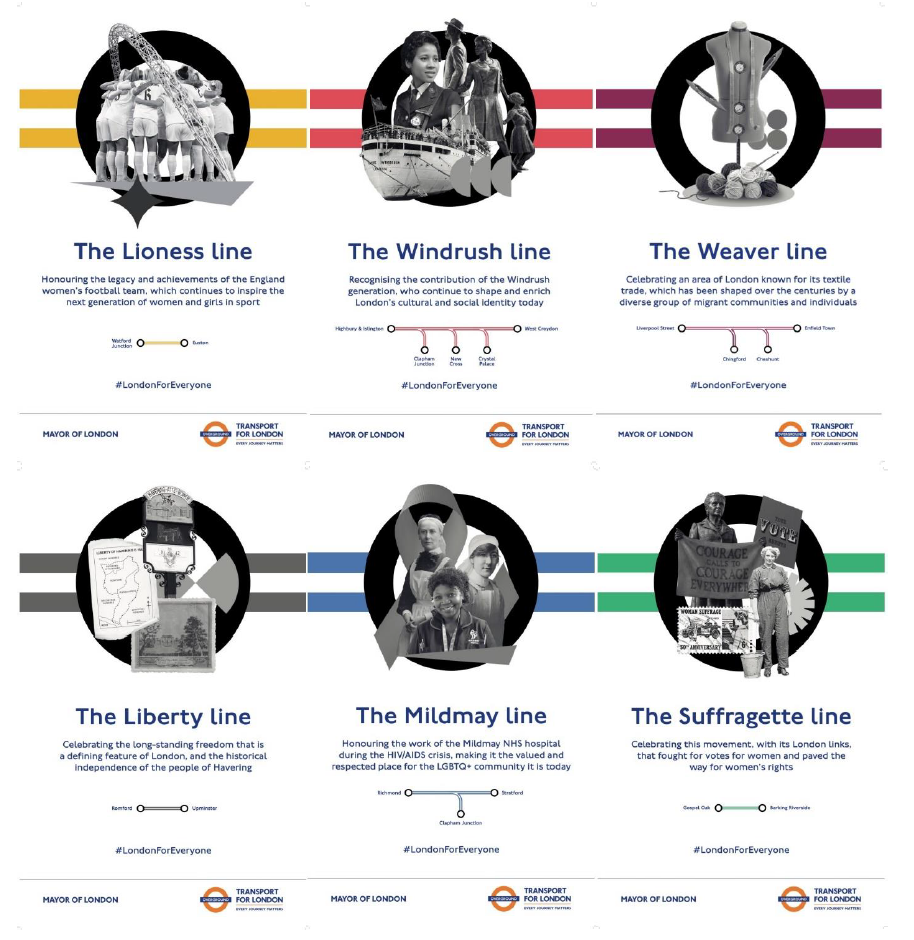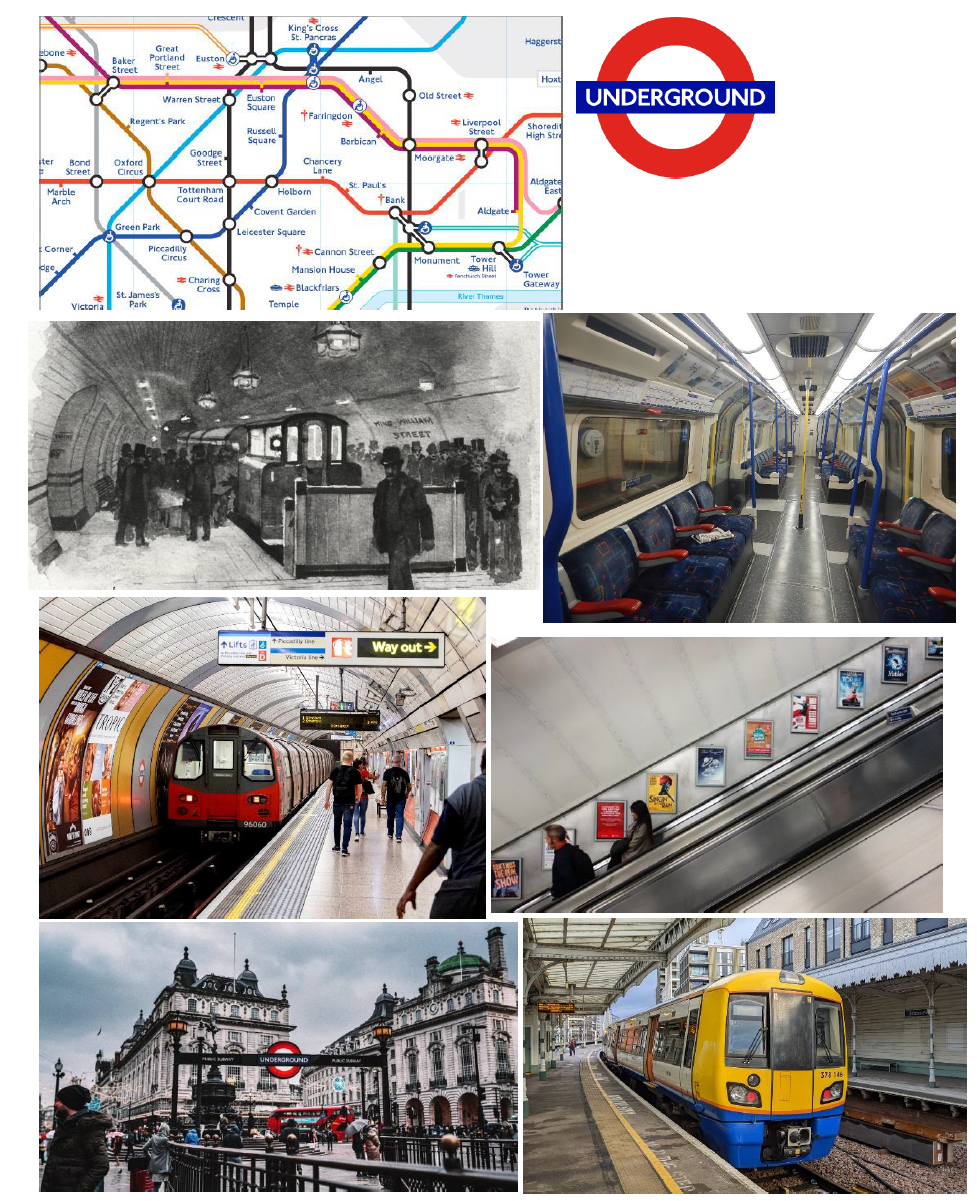 |
(2024.06.19) |
日本語と英語版があります。 This post is available in both Japanese and English, please scroll down for the English version.
ロンドンの地下鉄と鉄道
東京と同じように、イギリスの首都であるロンドン市には広域的な交通機関があります。去年ロンドンのバスについてブログを書きましたが、今回はロンドンの有名な地下鉄について紹介したいと思います。 英語標記で、それはロンドンの「underground・ウンダグラウンド」と書き、言葉で言うなら、「tube・チューブ」といいます。
日本語で「地下鉄」を表す言葉は1つだけですが、英語では「地下鉄」を表す言葉は「subway」、「metro」と「underground」があります。国次第で、使っている言葉が異なります。
「Subway」はアメリカの英語です。例えば、アメリカのニューヨーク市の地下鉄について話すときは、「subway」と言います。また、イギリス以外のヨーロッパの国では、「metro」と言うのが一般的です。例えばフランスのパリ市やギリシャのアテネ市の地下鉄では、「metro」を使います。
母語は英語ではありませんが、これらの国では看板に英語の訳もあり、「metro」と書いてあります。最後に、イギリスでは「underground」といいます。「Underground」の意味は文字通り「地下」です。「Under」は下、「ground」は地です。
次に、ロンドンの地下鉄の歴史について紹介します。ロンドンの地下鉄は、世界初の地下鉄でした。実は、電車の歴史の中で、イギリスにおける電車技術の発達が大きく影響を与えています。
1825年にイングランド北部で初めて乗客が乗る蒸気機関車が生まれました。1863年にはロンドン地下鉄が開業しました。それは、1路線、6駅の「メトロポリタン鉄道」でした。現在でも、メトロポリタン線という地下鉄線があり、34駅あります。ロンドン地下鉄全体では現在11路線、272の駅があります。
ロンドンの交通機関に、「Zone・ゾーン」と呼ばれるものがあります。ロンドンの中心部は「Zone 1」、郊外に行くにつれて、「Zone 9」まであります。どこのゾーンからどこのゾーンまで行くかは、電車の運賃で決まっています。中心部の運賃の方が中心部から離れている郊外よりも高くなります。ロンドンの区域は「borough」と呼ばれています。東京の「区」のようなものです。ロンドンには32区あります。勘違いしやすいですが、交通機関のゾーンと同じではありません。
最初に使われていた電車は、蒸気機関車でした。当たり前かもしれませんが、蒸気機関で動いていたため、煙が出ました。地下なので煙の換気が問題点でした。技術者達の解決策は、排気蒸気を冷水が入っているタンクに凝縮させる特別なパイプを取り付けることでした。トンネル内の煙は減りましたが、まだ量が多すぎて、トンネルにいる人々にとって呼吸が大変でした。
メトロポリタン鉄道は深いトンネルではなく地面から浅いところにありました。現在のように地面から深いところでトンネル建設が始まったため、換気ができない蒸気機関車が使えなくなりました。そのため、電気を使わなければなりませんでした。1890年にロンドンで世界初の深層電気鉄道を開業されました。名前はシティ・アンド・サウス・ロンドン鉄道でしたが、現在「Northern・ノーザン」線と呼ばれています。英語で「northern」の意味は北方です。この開業の後、他のロンドンの地下鉄線も同様に電化されました。
元々は複数の会社が地下鉄の路線を管理していました。しかし、20世紀初頭にすべての地下鉄路線を「London Underground」として名称と管理が統一されました。1933年にはバスや地下鉄ではない鉄道も含め、すべてのロンドン交通機関が統一されました。現在、すべてのロンドン交通機関を管理しているロンドン交通局(英語:Transport for London、略語TfL)が2000年に設立されました。TfLは地方自治体です。
地下鉄線の多くの路線の名称は「どこを通るか」に由来しています。例えば、「Piccadilly・ピカデリー」線(1906年開業)は「Piccadilly Circus」に止まります。「Central」の意味は中央なので、「Central・セントラル」線(1900年開業)はロンドンの中心部を走っています。
他の路線はイギリスの王室に関係しています。エリザベス2世以前に、1837年から1901年までイギリスの最長在位君主であったヴィクトリア女王が由来となっている「Victoria・ヴィクトリア」(1968年開業)という名前の路線があります。
また、地下鉄線ではありませんが、2022年に「Elizabeth・エリザベス」という鉄道が開業されました。理由として故エリザベス2世の在位は2022年の6月に70年となりました。初めて国王の在位が70年に達したため名前が付けられました。この時には、歴史的なイベントや初めてのプラチナジュビリーが行われました。ジュビリーとは、約10年ごとに国王の在位を祝うものです。ジュビリーの開催とエリザベス線の開業の後、2022年9月にエリザベス2世は崩御されました。ジュビリーと言えば、1977年にエリザベス2世の在位は25年になり、シルバージュビリーでした。「シルバー」の意味は銀です。このジュビリーを記念して、1979年に地下鉄の「Jubilee・ジュビリー」線が開業されました。また、「丸」を表す「circle」という言葉を使った「Circle・サークル」線という環状路線もあります。
また、それぞれの路線を表す色があります。ロンドンのウンダグラウンド地図を見ると、各路線の色を見ることができます。ロンドンの地下鉄にはロゴがあり、ロゴの色と路線地図が示す路線の色が同じです。下記のロゴをご覧ください。全ての路線の色について紹介します。
メトロポリタン線はマゼンタ・赤紫、ノーザン線は黒色、ピカデリー線は紺色、セントラル線は赤色、ヴィクトリア線は水色、ジュビリー線は灰色、サークル線は黄色です。他の路線について、ハマースミス&シティー線は(1864年開業)ピンク、ディストリクト線は(1868年開業)緑色、ウォータールー&シティー線は(1898年開業)ターコイズ、ベーカールー線は(1906年開業)茶色です。多くの地下鉄路線は開業から路線の延長が行われてきました。地下鉄路線ではないですが、エリザベス線は紫色です。
ロンドンは970万人以上が住む大都市であるため、「underground」だけではなく、他の鉄道も多いです。
「overground」は地下ではない鉄道の路線を表します。英語で「over」は「上」という意味なので、「overground」は地上という意味です。元々、現在の「オーバーグラウンド」路線は普通の鉄道でした。
ロンドンの中心部の周りの交通状況を改善するために、2007年にTfLは「London Overground」を発足しました。ロンドンの地下鉄にも郊外に行く路線がありますが、地下鉄がない区域もあるため、オーバーグラウンドはとても便利です。オーバーグラウンドの路線は2007年以前、それぞれ別会社に管理されていたため、管理が行き届いていませんでした。これはイギリスの鉄道における問題点です。イギリスではインフラ投資が不足しているため、鉄道路線が荒れてしまっています。ロンドンの交通機関は他のイギリスの地域と比べて便利で利便性が高いです。要するに、2007年のオーバーグラウンドの事業開始により、ロンドンにある鉄道のほとんどがTfLの管轄となりました。TfLはインフラに投資したため、2007年からはオーバーグラウンド路線の延長も行い、新しい線路も建設されました。
~ロンドンオーバーグラウンドにある路線の新名称を紹介しましょう~
今年、ロンドンオーバーグラウンドの路線にそれぞれの名称を付ける予定があります。今まで、地図を見ればオーバーグラウンドはオレンジでした。6路線あるにもかかわらず、全てダブルオレンジ線です。その結果、地図が分かりにくくなってしまいます。そのため、今年の秋からは6路線にそれぞれ名称を付け、別の色が与えられます。TfLは路線の名前の候補を発表しましたので、これから紹介します。名前は路線が走っている近くの歴史が由来となっています。名前を紹介しながら、ロンドンの歴史を少し説明します。
まず「Lioness・ライオネス」線があります。ライオネスの意味はメスのライオンで、ライオンはイングランドの国獣であり、イングランドのスポーツ代表チーム一般的に「ライオン」と呼ばれています。
最近では、イングランド女性サッカーチームが成功を手にしました。UEFA欧州女子選手権2022年に勝利を収め、2023 FIFA女子ワールドカップに決勝戦に出場しました。
今年下半期から「ライオネス線」になるオーバーグラウンドの部分はウェンブリー経由です。ウェンブリー・アリーナはイングランドサッカーチームの男女兼用のスタジアムなので、このオーバーグラウンドの部分はライオネス線の名前がついています。
最近のイングランドサッカー界では、女性チームと男性チームが平等に扱われるような運動が行われています。イングランドの女性チームは男性チームより試合に勝っています。にもかかわらず、イングランドの女性サッカー選手の給料は男性より低く、規模が小さいです。ライオネスの成功をきっかけに、多くの女の子がサッカーを始めたため、ライオネス線はその象徴となっていくことでしょう。ライオネス線の色は濃い黄色、薄いオレンジです。
次に紹介する新しい名称は「Windrush・ウィンドラッシュ」です。
1948年にカリビアンから出航したウィンドラッシュ号という船がイギリスに到着しました。1948年にイギリス国籍法が施行されて、イギリス帝国に属している国の人々は、イギリス国籍が与えられることとなりました。理由は、第二次世界大戦後、戦後復興しなければならず、経済回復も必要でしたが人手不足でした。そのため、乗船した人々はカリビアン系イギリス人となり、働くためにイギリスに移民しました。この人々は「ウィンドラッシュ世代」と呼ばれ、この時代の方の子孫は今でもイギリス人です。彼らがイギリスに来た当時は、人種差別が激しかったため、現在このカリビアン系の方々を表す、ウィンドラッシュ線の名前を選ばれました。ウィンドラッシュ線は多くのカリビアン系の方に住んでいる地域を通ります。ウィンドラッシュ線の色は赤色になります。
「ウィーバー・Weaver」という路線は歴史的な繊維産業があった東ロンドンの地域を通ります。17世紀から様々な国の移住者はこの繊維産業に携わることとなりました。特に、19世紀のユダヤ教難民と1960年代のバングラデシュ人は東ロンドンの繊維産業で働いていました。英語で「weave」の意味は「織る」、「weaver」の意味は「織っている人」です。ウィーバー線の色はマゼンタになります。
日本語で、「liberty」の意味は「自由」なので、「リバティー・Liberty」線はロンドンの自由さを象徴しています。その上、このオーバーグラウンド部分はヘイヴァリング区にあります。ヘイヴァリング区の標語は「リバティー」です。その地域に住む人は、中世に「ロイヤル・リバティー」という特別な地位が与えられ、王室ではなく、個人として土地を所有する権利がありました。リバティー線の色は灰色になります。
「Mildmay・マイルドメイ」線の名前は1860年代にあった慈善病院が由来となっています。この時代に牧師とその妻は貧しい人たちを救うため、マイルドメイ病院を設立しました。その病院は1980年代にヨーロッパで最初のHIV・AIDs患者専門の病院となりました。
ウェールズ公妃ダイアナは患者を支えるために17回もこの病院を訪問しました。この訪問をきっかけに、HIV・AIDSに関する同性愛者への差別が減ることとなりました。マイルドメイ線の色は青色になります。
最後に、「Suffragette・サフラジェット」線は女性解放運動が由来となった名前です。
1866年から女性解放運動が始まりましたが、1903年にサフラジェットという運動グループが設立されました。東ロンドンには労働者階級であるサフラジェットが多く、彼らは運動に参加しました。
この路線は東ロンドンにあります。イギリスでは1918年から30歳以上で財産を所有している女性が投票できるようになり、1928年から21歳以上の労働者階級の女性も選挙権を得ることとなりました。サフラジェット線の色は緑色になります。
要するに、オーバーグラウンドの6路線の新名称はロンドンの歴史、多文化社会と平等活動を表していると思います。アンダグラウンドの路線の名称より地域の歴史と関係していますね。
ロンドンのバスに興味があったら、2023年5月の記事をご覧ください。ロンドンバスと同じように、電車に乗ると「オイスター」というICカードを使うのが一般的です。オイスターの意味は牡蠣(かき)です。
他の地下鉄と比べて、ロンドンの地下鉄はユニークであると思います。理由を説明するのは難しいですが、丸く赤い正面がある電車、特徴的な地下歩道がある歴史的な駅、個人的な「tube・チューブ」のニックネーム、観光客からの人気が挙げられると思います。個人的に、「チューブ」と考えると、エスカレーターに立ち、壁に貼られたロンドンのウェストエンドで上演されるミュージカルのチラシを読むことを思い浮かべます。皆さん、ロンドンに行くとぜひウンダグラウンドに乗ってみてください!

The London Underground and Overground
As the UK's capital city, London has an extensive transport network. In May last year, I wrote a post about London's buses, but this time I want to discuss a different part of London's transport network, namely the famous London Underground, which is colloquially, and often affectionately referred to as "The Tube" by locals.
In Japanese, "地下鉄" is used to describe an underground railway, read as "chikatetsu". "Chi", "地" means earth or ground, "ka", "下" means under or below, and "tetsu", "鉄" is used in railway, although the character itself means iron. In English there are multiple ways to describe an underground railway, with the American English being "subway". In many European countries, underground rail networks are referred to as "metro", but in Britain we call it the "underground". So, if you go to London, make sure to say "underground", not "subway" or "metro"!
Regarding the history of the London Underground, it was the world's first ever underground railway, and Britain was one of the world's leading countries when it comes to rail and train developments. In 1825, the Stockton and Darlington Railway in the north of England became the world's first steam locomotive to carry passengers on a public line. In 1863, the first section of the London Underground opened, making history. It opened as one line with six stations and was called the "Metropolitan Railway". Today, the London Underground has a "Metropolitan Line" which has 34 stations. The entire London Underground network has a total of 11 lines, with 272 stations. So, it's safe to say it has expanded considerably since 1863! London's public transport network has Zones, with London's most central area being in Zone 1, and the outermost suburbs being in Zone 9. As you travel between Zones, the travel fare changes, with the central zones being more expensive. Not to be confused with these transport-related Zones, London's administrative divisions are called "boroughs", and there are 32 boroughs in London.
The Underground's earliest trains were steam trains, and it goes without saying that they produced smoke, creating problems with ventilation when using them underground. Engineers looked to reduce the amount of smoke by fitting special pipes to condense the exhaust steam into side tanks of cold water. While this helped, the amount of smoke in the tunnels was still an unpleasant problem for passengers. The Metropolitan Railway was not a deep-level tube like the ones today, instead the tunnel was built just below the ground by digging a huge trench, laying track, building a brick archway and then resurfacing over the top. From 1890, deep level tunnels were introduced, which made the usage of steam locomotives on the Underground no longer a viable option, so the network was gradually electrified. Electric traction began to be used to power the trains, and new electric trains were built specially. What is now the Northern Line opened in 1890 as the City & South London Railway, becoming the world's first deep-level underground electric railway.
Originally, multiple companies operated different underground rail lines in London, but in the early 20th century the lines were amalgamated under the name "London Underground", and in 1933 all of London's public transport (including buses and overground trains) came under the control of one organisation. (The operation and management of overground trains in London would vary over the years due to the privatisation of Britain's railways in the 1990s.) In 2000, the network's current form took shape when the local government body Transport for London (TfL) was established, taking control of London's public transport network.
Looking at the name of the Underground's lines, they are often linked to which areas the line goes through. For example, the Piccadilly Line (opened 1906) stops in Piccadilly Circus and the Central line (opened 1900) travels through central London. Other lines have names that relate to the British royal family, for example Queen Victoria, who reigned from 1837 to 1901. Before Elizabeth II, she was the longest reigning British monarch, and in celebration of her historic reign, during which the industrial revolution occurred, there is a Victoria Line (opened 1968). On the subject of Elizabeth II, although it is not an Underground line, in 2022 the Elizabeth Line opened in celebration of her Platinum Jubilee in June 2022, which marked her historic 70 years on the throne. She was the first ever British monarch to reach this milestone, and the Elizabeth Line marked this by opening in the same year. Sadly, in September 2022, following the Jubilee and the opening of the line, Elizabeth II passed away. A Jubilee is an event that celebrates milestones in the reign of monarchs, speaking of which, in 1977 Elizabeth II celebrated her Silver Jubilee, which marked 25 years on the throne. Following this, in 1979 the Jubilee Underground Line opened in celebration. It is different from the above line-naming trends, but there is also a Circle Line on the London underground, aptly named because the line is a loop line.
Every Underground line has its own colour, which makes it easier to differentiate each line when you look at the Tube map. The London Underground also has a logo which adorns stations' entrances, and while the logo is normally red with dark blue it sometimes appears in the colour of each line. Regarding the colours of the aforementioned lines, the Metropolitan Line is magenta, the Northern Line is black, the Piccadilly Line is dark blue, the Central Line is red, the Victoria Line is light blue, the Jubilee Line is grey, and the Circle Line is yellow. The colours of the lines I haven't discussed above are as follows: the Hammersmith & City Line (opened 1864) is pink, the District Line (opened 1868) is green, the Waterloo & City Line (opened 1898) is mint green/ turquoise, and the Bakerloo Line (opened 1906) is brown. Most of the lines have been extended since they began operations. The Elizabeth Line isn't a Tube line, but its colour is purple.
Since London is a big city with a population of over 9.7 million people, the Underground isn't the only train network in the city. Another key train network is the London Overground, also run by TfL. Originally, what is now the London Overground were usual train lines, called the Silverlink Metro, operated in the same way train lines around Britain are (a franchise system in which private companies are contracted), instead of under the same umbrella as the Tube. In 2007 TfL took over management of the lines to improve the transport links in areas outside of central London, and so the Overground was born. The Underground also has lines that go to the outskirts of London, but there are some areas of London that have no Tube links, so the Overground proved useful and necessary in these areas. Prior to 2007, while most of the sections of train line that would become the Overground were there, they were a little worse for wear. In fact, a significant portion of Britain's train networks across the entire country aren't in great shape due to a lack of investment by the companies in charge of them. Public transport in London is usually far more convenient and effective than in other parts of the UK. Establishing the Overground in 2007 meant that these train lines were brought under TfL's local government control rather than being under a private company, following which they were improved as TfL invested in the infrastructure. Since 2007, there have also been extensions to the Overground line, with new tracks being constructed in areas of London that lacked rail links.
☆Introducing the new names of the Overground lines!☆
Early this year, TfL announced new names for each Overground line which it plans to implement from autumn this year. Until now, while the London Overground has different lines within its network, it's been known only as the Overground, and has appeared as such on transport maps. The Overground's colour is orange, and on the Tube map, all 6 of the Overground lines are shown as double orange lines. This makes it quite difficult to read the map and see clearly which parts of the Overground network are connected to each other. So, all 6 lines have been assigned a new name and colour. TfL has already launched the names and explanations for why they were chosen, which I will introduce below. They are all linked to the history of the areas they travel through, so I will also briefly explain the attached histories.
First is the Lioness Line, which will pass through Wembley where England football's national stadium, Wembley Stadium, is located. The national animal of England is the Lion, and English sports teams, in particular our most popular sport, football, are often referred to as "the Lions". Recently, women in sport have made headway and the England women's football team, nicknamed "the Lionesses" have achieved great success, which this line will celebrate. They won the UEFA Women's Euro in 2022 and were runner's up in the 2023 FIFA Women's World Cup. In recent years there have been calls to make women footballers equal compared to their male counterparts, as there is still significant inequality, for example in terms of salary and investment. The Lionesses have been more successful than the men's team in recent years, since the men have not reached a World Cup final since their 1966 win, and have never won the Euros, (although they did reach the final in 2021, and only time will tell with this summer's championship). As a result of the Lionesses' achievements, more girls have been inspired to play football, and the new Lioness line will represent their impact and what it means for women and girls in sport. The Lioness Line's colour will be dark yellow/ pale orange.
Next is the Windrush line, named after the boat which in 1948 brought Caribbean people to live and work in Britain, creating the Windrush generation. That same year, the British Nationality Act had given people living in British colonies the right to British nationality. The British government wanted people from across the British Empire to come and work in Britain to help rebuild from the destruction of the Second World War, and aid economic growth by filling the worker shortage. So, over 1000 people from across the Caribbean boarded the Windrush to support and work in Britain, becoming the Windrush generation of British Caribbeans. Now, the Windrush generation are grandparents or perhaps even great grandparents. When they first came to Britain, they experienced racism, which has in some cases continued until today, for example with the recent Windrush scandal, which has yet to be remedied. To acknowledge their struggles and also to celebrate this generation and their great contributions to London's culture, the name Windrush has been chosen. The Windrush Line will travel through areas with strong ties to Caribbean communities, and its colour will be red.
The Weaver Line will go through areas of East London where the textile industry thrived throughout history. Since the 17th century, different immigrant groups have worked in the textile industry and helped it to flourish. These groups include the Huguenots in the 17th century, who were a group of French Protestants forced to flee religious persecution in their own country, Irish weavers in the 18th century, Jewish people who fled persecution in the late 19th century and during the Second World War, and Bangladeshi workers in the 1960s. The Weaver Line's colour will be magenta.
The Liberty Line will represent freedom as a defining feature of London, according to TfL. It is also linked to the area the line travels through, the borough of Havering, which has historical significance as during the Middle Ages it was a "Royal Liberty". This means that it had special freedom from royal jurisdictions, for example with someone other than the royal family having rights over the land. The Liberty Line's colour will be grey.
The Mildmay Line is named after the charitable hospital which opened in 1860. It was opened by a Reverand (a minister of religion) and his wife to help Londoners in need. It later became Europe's first hospital for those with HIV- and AIDS-related illnesses in 1988, which was pivotal given the amount of stigma and discrimination faced by patients with such illnesses at the time. Princess Diana was an advocate for helping those with HIV and AIDS and so visited Mildmay Hospital 17 times. The press coverage her visits brought helped to reduce the stigma patients faced at the time, which particularly affected the LGBTQ+ community. The Mildmay Line's colour will be blue.
The final new Overground line name is the Suffragette Line, which will celebrate London's pivotal women's liberation movement, with a focus on women gaining the right to vote. The movement began in 1866, and the Suffragettes formed as a group within this movement in 1903. In the areas of East London this section of the Overground travels through, there was a subgroup of Suffragettes called the East London Federation of Suffragettes, whose members were mostly working class. In Britain, property-owning women over the age of 30 were granted the right to vote in 1918, while everyone over the age of 21 (including women) was granted the right to vote in 1928. The Suffragette Line's colour will be green.
In conclusion, the 6 new Overground line names represent London's history, multiculturalism and equal rights campaigns. The names of the Overground lines are relevant to the local histories of the areas they are linked to, more so than Underground line names. If you are interested in London's famous red double decker buses, please take a look at my May 2023 blog post! You can use the same payment card on the Tube and Overground as on the buses, which is London's Oyster card. Compared to other underground railway lines I have ridden around the world, I've found that the Underground has a unique feel to it. It's tough to say why, but perhaps it has something to do with the round red front of the trains, the unique walkways in the historic stations, the "Tube" nickname, or its global fame and resulting popularity with tourists. When I think of the Tube, I picture myself standing on the escalator looking at the posters on the wall advertising the musicals playing on the West End. If you visit London, make sure to take the Underground!

-
イメージの出典・Image descriptions:
左上から右下まで・From top left to bottom right
- 6つのロンドンオーバーグラウンド新名称の情報発送 New Overground name information release https://madeby.tfl.gov.uk/2024/02/15/overground_line_names/?intcmp=75213
-------ライオネス線・ウィンドラッシュ線・ウィーバー線・リバティー線・マイルドメイ線・サフラジェット線
------ ***
- ロンドン地下鉄の地図の部分(テムズ川が入っている) A section of the Tube map (River Thames included) https://www.visitlondon.com/traveller-information/getting-around-london/london-maps-and-guides/free-london-travel-maps
- ロンドン地下鉄のロゴ London Underground logo https://commons.wikimedia.org/wiki/File:Underground.svg
- 19世紀後半のロンドン地下鉄駅 London Underground station in the late 19th century https://www.ltmuseum.co.uk/collections/stories/transport/king-william-street-ghost-station-worlds-first-deep-level-electric
- ロンドン地下鉄の電車内 London Underground train interior https://anonw.com/2018/07/08/inside-a-piccadilly-line-1973-stock-train/
- ロンドン地下鉄のホームと電車 London Underground platform and train https://wired.jp/article/london-underground-ai-surveillance-documents/
- ロンドン地下鉄のエスカレーター London Underground escalators https://worcesterrugby.org/product_details/23761503.html
- ロンドン地下鉄の駅入口 London Underground station entrance https://www.tripadvisor.co.uk/Articles-lNnVaycjJUvc-How_to_use_london_underground.html
- ロンドンオーバーグラウンドのホームと電車 London Overground platform and train https://www.ianvisits.co.uk/articles/london-overground-planning-150-million-maintenance-contract-71787/
















